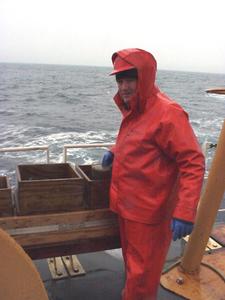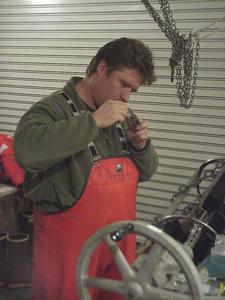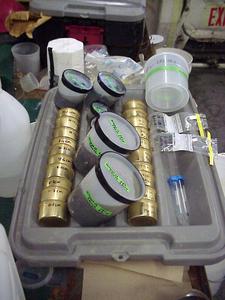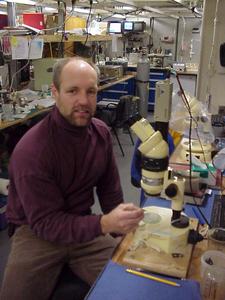
|
|
18 August, 2002
Although the weather has finally let up, things have certainly not slowed
down science-wise. During the rough weather, just about the only work that
could be done was the work off the stern of the ship. That meant pumping
and benthic work. Now that we are back to "normal" we are also at the end
of the West Hanna Shoal line where the stations get gradually shallower.
We've gone from 1000 meters to 500 m, to 200 m, to 100 m and now to 50 m. I
admit that I'm having a hard time keeping the day and date straight! It
helps a bit that it now gets almost dark during the early morning hours, so
I can at least distinguish day and night. It's a busy time and an
exhausting time for everyone, but the cruise is winding down, and all the
scientists want to make the best use of the time we have left. I'm going to
take a bit of time to tell you about two more members of our science team
and one new member of the Coast Guard MSTs.
Shortly after the storm passed, I had a chance to talk with the new MST on
board. Remember that it is the Marine Science Technicians who coordinate
and support all the science on board ship. (See my journal of August 9.)
Josh Robinson is not only new to the Healy, but this is the first time he
has been stationed on a ship. He has been in the Coast Guard for six years,
but has always been on land. He was at a communications station on Kodiak
Island, Alaska, and he was in a marine safety office in Texas where his job
was pollution prevention. He's excited to be on board a ship, and finds the
science extremely interesting. Josh also mentioned that he had taken
classes on the weather so I asked him about our recent storm. He told me
that anytime the barometer drops more than 24 millibars in 24 hours, it is
called a "bomb." During the storm we just had, the barometer dropped from
1018 to 993 millibars in less than 12 hours, after which it dropped even
further to 983 millibars! Another interesting fact about the storm is that
we found snow in our sieves on the morning that the wind chill was -5
degrees Fahrenheit.
Whenever I'm doing the benthic work, the person I spend the most time with
is Jim Bartlett. Jim is a Senior Research Assistant working with Jackie
Grebmeier and Lee Cooper. Jim first worked for them in 1990 and, despite
taking time off for graduate school and to work other jobs, this is his 8th
cruise with Jackie and Lee. He's now working for them full time again. Jim
is a wealth of information and I continually ask him questions as we sieve
mud from the van Veen grabs, section cores from the Haps core, and can the
mud we get from the sectioning. In addition to his knowledge of
invertebrates (animals without backbones), Jim has extensive knowledge of
fish and fisheries. His Masters degree is in biology with a concentration
in fish physiology, and he has worked as an observer for the National Marine
Fisheries Service in Seattle where most of his work was in the Bering Sea.
He has also worked for the U. S. Forest Service doing a fresh water fish
survey in Mississippi National Forest Lands.
Today I had lots of questions for Jim, because we were finding several
different kinds of organisms in our van Veen grabs. While we are on the
shallow end of the West Hanna Shoal transect, we are on the shelf. Remember
that the shelf is where the ocean bottom is shallow immediately off the
land. Where we are now, nutrient rich water from the Pacific Ocean is
bringing lots of food to the organisms here in the Chukchi Sea. As a
result, Jim had to help me identify the many different organisms that we
found when we sieved the mud from the van Veen grabs. For example, we found
many bivalves (bi = two and valve = shell) and gastropods (snails). The
bivalves included a beautiful golden colored clam called Yoldia and a
pretty, almost white one called Macoma calcarea. We also found pink brittle
stars (a type of starfish with a small body and long, thin arms), orange sea
cucumbers less than an inch long, lots of maldanid polychaetes (big worms),
and even a small snow crab. All of these organisms live on the bottom and
benefit from the nutrient-rich Pacific waters which feed the phytoplankton
above them. Because it is so shallow here, lots of the phytoplankton make
it to the bottom to provide food for all those living there. Another way we
know that the phytoplankton reach the bottom is by taking sediment
chlorophyll measurements whenever we bring up the van Veen grab or the Haps
core. When there are a lot of phytoplankton there is always a lot
chlorophyll in the sediments, and that's exactly what Jackie and Lee are
finding here.
There's one other "new" member of the science team although he is an "old
hand" at this since he was on the spring SBI cruise. A little over two
weeks ago, Bob Campbell arrived on board by helicopter. Bob is a marine
scientist at the University of Rhode Island School of Oceanography, and he
is working with Carin Ashjian and Stephane Plourde on their copepod research
(see the journal for July 28). Bob was late joining this cruise because he
was working on another project in the Bay of Fundy off the coast of Canada.
On that cruise he was studying the role of zooplankton in harmful algal
blooms. It's part of a large study called ECOHAB (the Ecology of Harmful
Algal Blooms). Remember that algae are phytoplankton, the primary producers
of the ocean. Some algae also produce a toxin (poisonous substance), which
can be harmful to other marine organisms when the algae reproduce in large
numbers (bloom). Bob was trying to find out if the zooplankton in the Bay
of Fundy are eating the potentially harmful algae.
Another project that Bob worked on was the SHEBA project (Surface Heat
Budget of the Arctic Ocean). The project involved freezing a Canadian
icebreaker into the Arctic ice for almost a year. Most of the research
being conducted by the scientists on board was in the area of physics and
climate, but Bob worked on zooplankton productivity (abundance and growth
rates). That's where he first worked with Ev Sherr who is working closely
with him on the two SBI 2002 cruises (see my journal for August 8).

<> Jim Bartlett and I always work together to sieve the mud from the van Veen grabs. While most of us wear mustang suits on deck, Jim prefers his bright orange rain gear. When the weather was extremely rough, everyone had to wear a mustang suit and go on deck in pairs. Even Jim wore a mustang suit on deck during that time!

<> Jim is always extremely careful when he takes the sample of surface mud which will later be analyzed for the amount of chlorophyll in the sediments we get from both the van Veen grabs and the Haps core.

<> These are all the things that get labeled and filled (by Jim, me, Lee and Jackie) whenever we do a benthic sampling. The cans are for the mud we get when we section the core. The blue topped tubes are for a tiny sample of surface mud to be analyzed for sediment chlorophyll. The large beaker at the top right is a Marinelli Beaker which we fill with mud to be analyzed for Beryllium-7, an isotope used to track sedimentation rate. All the plastic cups are filled with organisms that we get when we sieve the mud. The two plastic bags are for mud samples for TOC (Total Organic Carbon) and HPLC (High Performance Liquid Chromatography).

<> Bob Campbell works at the University of Rhode Island School of Oceanography. He joined us a little over two weeks ago and he has been working with Carin Ashjian and Stephane Plourde on their zooplankton studies.
Contact the TEA in the field at
.
If you cannot connect through your browser, copy the
TEA's e-mail address in the "To:" line of
your favorite e-mail package.
|
